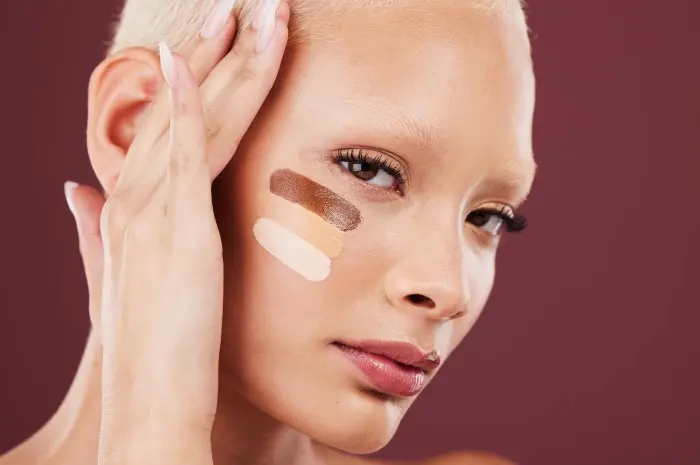Finding the perfect foundation for your skin is a crucial step in creating a flawless makeup look. However, with the plethora of options available in the cosmetics market, selecting the right foundation can be a daunting task.
This comprehensive guide will help you navigate through the process of choosing the perfect foundation for your unique skin type, tone, and needs.
Understanding Your Skin Type
Before you start exploring the world of foundations, it’s essential to understand your skin type. The four primary skin types are:
- Oily Skin: Oily skin tends to produce excess sebum, leading to shine and enlarged pores.
- Dry Skin: Dry skin lacks moisture and can feel tight, rough, or flaky.
- Combination Skin: Combination skin exhibits characteristics of both oily and dry skin, with an oily T-zone (forehead, nose, and chin) and drier cheeks.
- Normal Skin: Normal skin is well-balanced, with minimal oiliness or dryness.
Similar Post: Kraton Waterpark Krian, Family Favorite Water Tourism in Sidoarjo
Selecting the Right Formula
Once you’ve determined your skin type, choosing the right foundation formula is essential:
- Liquid Foundation: Liquid foundations are versatile and available in various finishes, including matte, satin, and dewy. They work well for all skin types, depending on the formula.
- Powder Foundation: Powder foundations are excellent for oily skin as they offer a matte finish and help absorb excess oil. They are also quick and easy to apply.
- Cream Foundation: Cream foundations are best for dry or mature skin, as they provide extra moisture and offer a satin or dewy finish.
- Stick Foundation: Stick foundations are convenient for touch-ups and provide medium to full coverage. They work well for normal to combination skin.
- Mineral Foundation: Mineral foundations are often gentle on sensitive skin and provide a natural, buildable coverage with a matte finish.
Choosing the Right Shade
Selecting the correct shade of foundation is crucial for achieving a seamless look. Follow these tips:
- Determine Your Undertone: Skin undertones can be warm, cool, or neutral. Warm undertones have yellow or golden hues, cool undertones have pink or blue hues, and neutral undertones are a mix of both.
- Test in Natural Light: Always swatch foundation on your jawline in natural light to ensure it matches your skin tone. The shade that disappears into your skin is the right one.
- Sample Multiple Shades: Don’t hesitate to ask for samples or testers when shopping for foundation. Trying different shades can help you find the perfect match.
- Consider Seasonal Changes: Your skin tone may change slightly with the seasons due to sun exposure or other factors. Be prepared to adjust your foundation shade accordingly.
Coverage Levels
Foundation comes in different coverage levels, ranging from sheer to full:
- Sheer Coverage: Sheer foundations provide a natural, lightweight finish. They even out the skin tone without hiding imperfections completely.
- Light to Medium Coverage: These foundations offer more coverage while still allowing some natural skin texture to show through. Ideal for everyday wear.
- Full Coverage: Full-coverage foundations are best for concealing blemishes, redness, and imperfections. They provide a flawless, polished look but may feel heavier on the skin.
Skin Concerns and Additional Features
Consider your specific skin concerns and any additional features you desire in a foundation:
- SPF: If sun protection is a priority, choose a foundation with added SPF to shield your skin from harmful UV rays.
- Hydration: Look for foundations with hydrating ingredients like hyaluronic acid or glycerin, especially if you have dry skin.
- Oil Control: For oily skin, opt for foundations labeled “oil-free” or “matte” to control shine.
- Long-Wear: If you need your makeup to last all day, choose a long-wear or transfer-resistant foundation.
- Acne-Prone Skin: Non-comedogenic foundations won’t clog pores and are ideal for acne-prone skin.
Highlight: Saygon Waterpark, Enjoy the Sensation of Various Interesting Rides in Pasuruan
Application Techniques
The way you apply your foundation can significantly affect the final result. Consider these application techniques:
- Makeup Brushes: Use a foundation brush for a precise, airbrushed finish. Flat-top brushes provide fuller coverage, while stippling brushes create a lighter, more natural look.
- Beauty Blender or Makeup Sponge: Dampen a makeup sponge to apply foundation for a seamless, dewy finish. Blend in a bouncing motion.
- Fingers: Your fingers can be an effective tool for applying foundation, especially if you want sheer coverage. Warm the product between your fingertips and blend onto your skin.
- Primer: Applying a makeup primer before foundation can improve its longevity and create a smoother canvas for application.
Setting Your Foundation
To ensure your foundation lasts throughout the day, set it with a setting powder or spray. This step helps control shine and minimizes the need for touch-ups.
Conclusion
Choosing the perfect foundation for your skin can transform your makeup routine and boost your confidence.
By understanding your skin type, selecting the right formula and shade, considering coverage levels and additional features, and mastering application techniques, you can achieve a flawless complexion that enhances your natural beauty.
Don’t be afraid to seek advice from makeup professionals or try samples to find the foundation that suits you best. With the right foundation, you can create a flawless canvas for any makeup look you desire.
